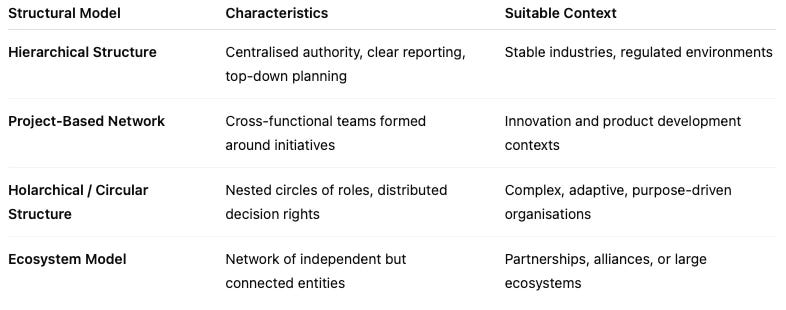From Fixed Design to Adaptive Architecture
Traditional organisational structures are designed for stability: clear reporting lines, defined functions, and predictable decision flows. While these features provide control, they often limit adaptability in dynamic environments.
Metamorphic Structure Practices enable the organisation to retain coherence while continuously adjusting its shape, roles, and decision pathways. The goal is not permanent reorganisation but continuous adaptability — the ability to evolve structure in response to purpose, context, and capability.
The Logic of Metamorphosis
Metamorphic structures apply a simple but powerful logic:
Structure follows purpose, and purpose evolves with context.
This approach recognises that organisational design must shift as strategic intent, market conditions, and workforce capabilities change. Instead of static charts, the organisation becomes a living architecture — a network of evolving roles, accountabilities, and learning loops.
The result is an enterprise that is both stable at its core and flexible at its edges.
Principles of Metamorphic Design
The following principles guide how Alive Organisations structure themselves:
Adaptation to Purpose
– Teams and governance models are reviewed regularly to ensure alignment with the organisation’s current intent.
– Structural change is treated as a normal management function, not an exceptional event.Distributed Authority
– Decision rights flow toward knowledge and accountability, not hierarchy.
– Leaders act as enablers rather than controllers, focusing on capacity-building.Transparency and Access to Information
– Data and decisions are visible to those who need them.
– Shared visibility increases speed, trust, and self-correction.Role Fluidity
– Roles evolve dynamically as projects and priorities shift.
– Individuals may hold multiple roles, adjusting contribution levels as context changes.Continuous Learning and Review
– Regular reflection (e.g., retrospectives, after-action reflections) ensures structural feedback.
– Learning outcomes inform the next design iteration.
These principles replace rigid control with governed flexibility — the ability to adjust without losing direction.
Structural Models for Dynamic Environments
Organisations adopt different structural patterns depending on size, industry, and maturity. The following models often appear along a developmental continuum:
A Metamorphic Organisation moves fluidly between these patterns, combining elements as needed. The design is not fixed, but context-responsive.
Decision Architecture
Decision-making is a key determinant of adaptability. Metamorphic structures distribute decisions according to relevance and capability rather than position.
Typical architecture includes:
Strategic Decisions: taken collectively by leadership or purpose councils, informed by foresight and context.
Operational Decisions: delegated to cross-functional teams or roles with direct knowledge.
Tactical Decisions: made autonomously by individuals following clear principles.
Each level operates under shared purpose, transparent information, and agreed escalation paths. This approach reduces bottlenecks while maintaining accountability.
Governance and Coordination
Governance replaces control with coordination. The structure is supported by clear but flexible mechanisms:
Purpose Councils: groups that monitor alignment between organisational design and strategic intent.
Role Governance Meetings: regular reviews of roles, accountabilities, and interfaces.
Integration Platforms: systems or processes ensuring information flow between units.
Feedback Channels: formal methods for raising structural tensions (e.g., through retrospectives or improvement logs).
These mechanisms enable continuous adjustment without the disruption of large-scale reorganisations.
Technology as Structural Enabler
Modern structures are increasingly supported by digital collaboration and decision platforms. These systems provide shared visibility into priorities, accountability, and progress.
Agentic AI contributes by:
Monitoring workflow data to identify structural inefficiencies.
Providing simulations for resource reallocation or scenario planning.
Acting as an advisory layer in governance meetings, summarising performance trends or emerging bottlenecks.
Technology does not dictate design but extends structural awareness, allowing leaders to act based on evidence rather than assumption.
Integration with Other Pillars
Metamorphic Structure serves as the structural complement to the other pillars of aliveness:
This integration ensures that the organisation’s form reflects its human, relational, and strategic dimensions.
Metrics for Structural Health
Alive Organisations measure structure not by hierarchy depth but by responsiveness.
Common indicators include:
Decision Latency: time between issue identification and resolution.
Role Clarity Index: level of understanding of responsibilities across teams.
Adaptation Cycle Time: frequency and quality of structural reviews and updates.
Engagement Correlation: link between perceived autonomy and employee engagement.
Monitoring these metrics helps ensure that adaptability does not compromise coherence or performance.
Benefits of Metamorphic Structures
When effectively implemented, Metamorphic Structures lead to:
Faster decision cycles and reduced operational friction.
Greater resilience during market or regulatory shifts.
Higher innovation throughput through cross-functional collaboration.
Increased ownership and accountability at all levels.
Improved alignment between strategy, purpose, and structure.
The organisation becomes a responsive system — capable of evolving as its environment and purpose evolve.
Definition
Metamorphic Structure Practices are the organisational design and governance disciplines that enable continuous adaptation of roles, processes, and decision flows in alignment with purpose and context.
They provide stability through clarity and flexibility through transparency — creating structures that evolve without losing coherence.
Conclusions
With structure now aligned to continuous adaptation, Part III – Practices in Alive Organisations reaches completion. Together, the four practice families — People, Value Co-Creation, Purpose, and Structure — form a comprehensive system for embedding aliveness into daily operations.
The next step in the overall narrative will transition from practice to integration: how these principles combine to shape the full lifecycle of an Alive Organisation — from design and implementation to continuous evolution.
Enjoy reading and applying these content. If you’d like to receive additional information regarding Alive Organisations topic please subscribe below.




